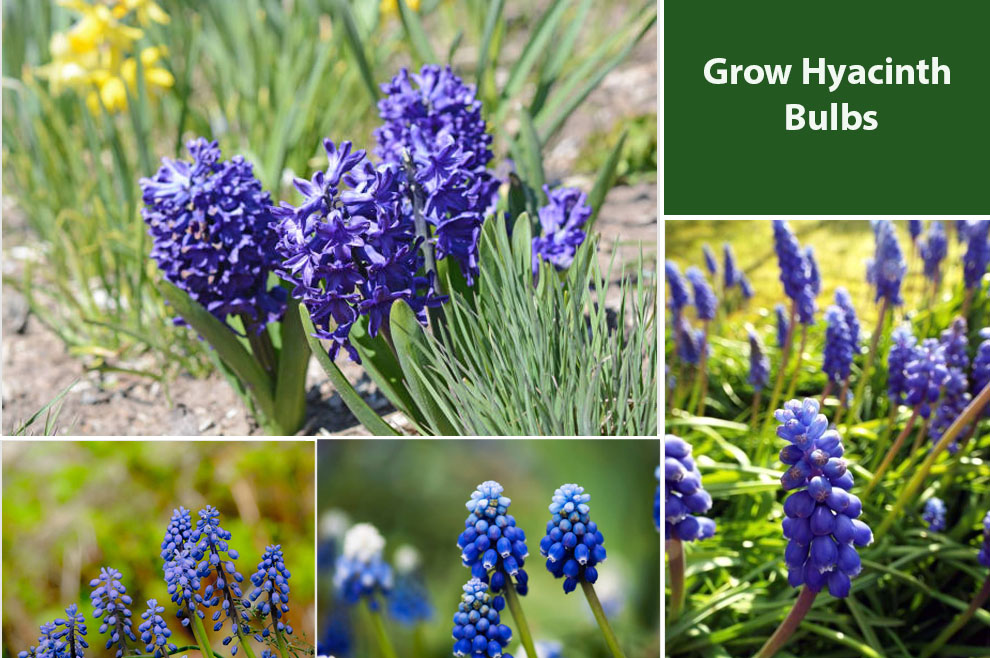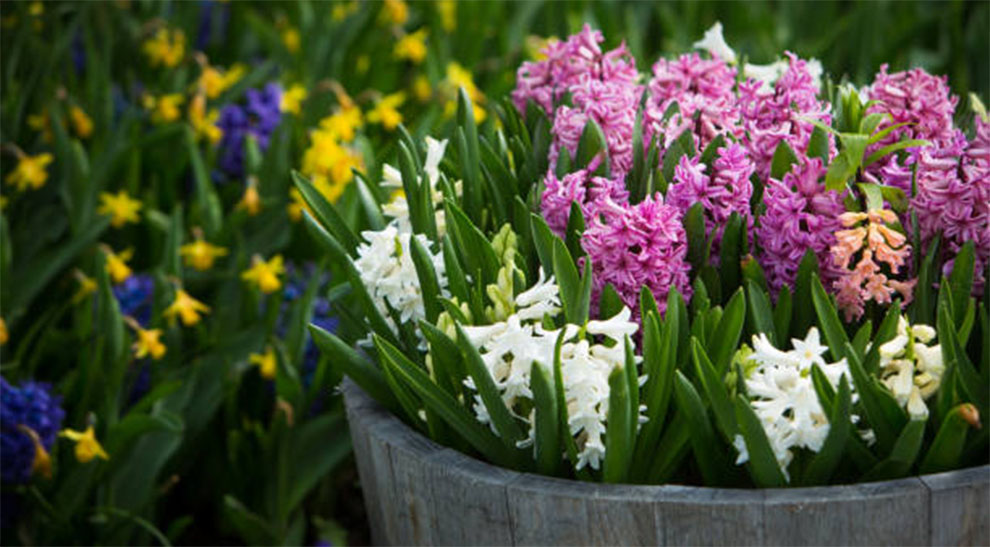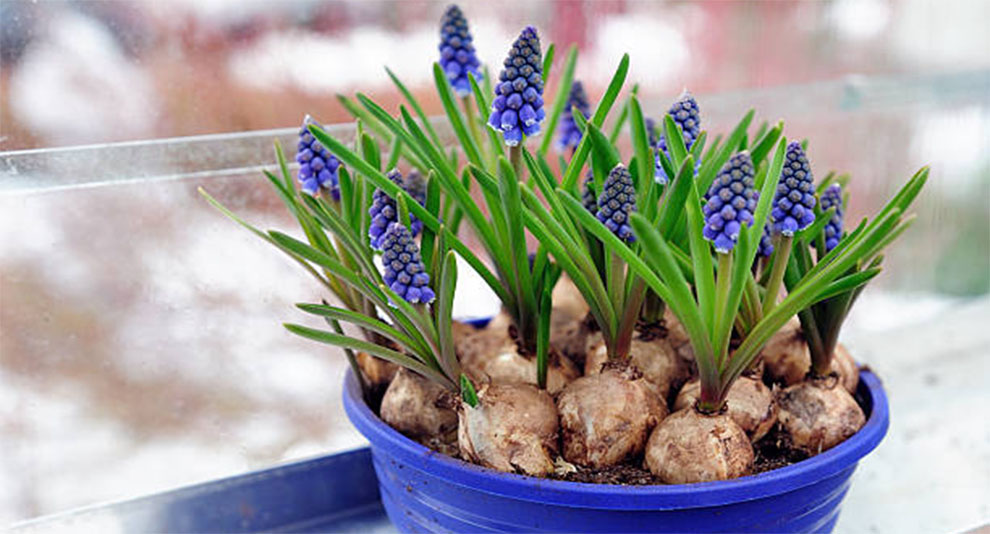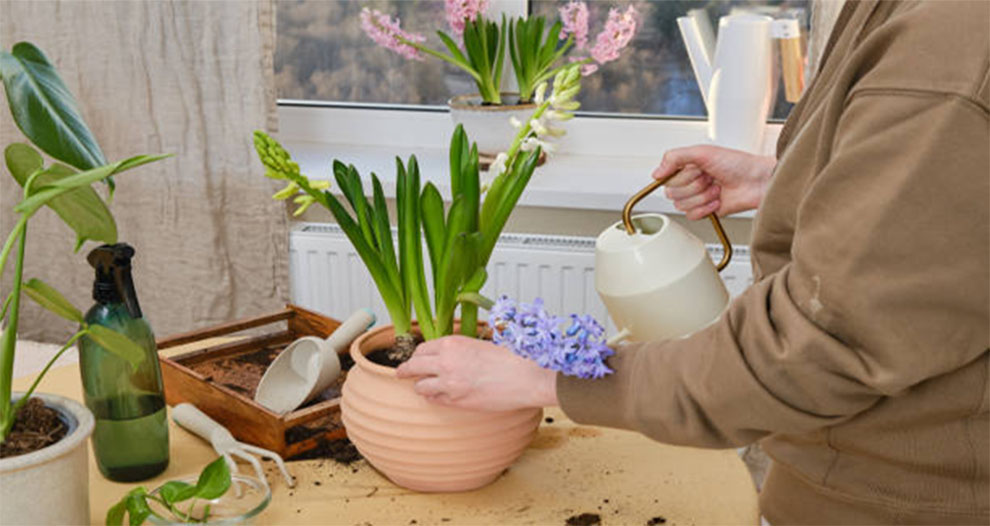How To Grow Hyacinth Bulbs: Planting & Guide & Care Tips
To grow hyacinths, you must plant their bulbs in fall. Plant them around six inches deep in well-drained soil in a well-lit location. You must water them regularly but only when the top soil feels dry. No need of fertilizers at the planting time if the soil is good.

Planting hyacinth bulbs is a delightful endeavor that rewards you with fragrant vibrant blooms. This guide will offer a concise overview of how to plant hyacinth bulbs, ensuring a successful venture for seasoned gardeners and beginners.
Each step is imperative for fostering healthy hyacinths, from picking the right hyacinth bulbs of your preferred variety to selecting an optimal planting location.
Generally, hyacinths thrive in a sunny spot in well-draining soil. You can simply dig a hole about 6 inches deep and plant the bulb ensuring the pointy end of the bulb faces upward. Space them 4-6 inches apart. Water them after planting.
Further, you need to look after their post-planting care, setting the stage for a beautiful floral display across spring. With some knowledge and patience, you can enjoy the fragrance and beauty of these charming springtime blooms.
How To Grow Hyacinth Bulbs – Things To Consider Before Planting Them!
Below, we will offer step-by-step instructions on successfully growing hyacinth bulbs, ensuring a vibrant display of blooms in your indoor space or garden.
1. Choosing The Hyacinth Variety
When growing hyacinth bulbs, the first and the most crucial step is picking a suitable variety. You can find Hyacinths in several colors, each with a unique fragrance and charm.
So, when opting among the available kinds, consider factors like bloom color, size, and time to ensure your chosen variety complements the indoor space or garden.
Go with varieties like Deft Blue or Blue Jacket for early spring displays. However, if you wish to see beautiful and elegant white blooms in your yard, Carnegie can be a good pick.
Jan Bos and Woodstock are exceptional choices for their pink and purple flowers. Further, there are multi-flowering varieties like Gypsy Queen that have a more dynamic show.
Take time exploring the options to pick the hyacinth variety that best matches your garden environment and aesthetic preferences.
2. Buying Quality Hyacinth Bulbs
When shopping for hyacinth bulbs, prioritize factors like the absence of mold, firmness, and bulb size. Go with bulbs that are firm to touch, plum, and free from any signs of mold or decay.
The bigger bulbs usually yield more robust blooms. Do not pick spongy or soft bulbs, as they may be compromised. You must always shop from reputable nurseries or suppliers, ensuring a higher quality likelihood.
Further, be mindful of the specific variety’s recommended bulb size for optimal growth. Investing in superior bulbs sets the stage for a vibrant and thriving hyacinth garden in the seasons to come.
3. Forcing Hyacinth Bulbs (Optional Step)

Though optional, it is a rewarding step for those hoping for an early burst of spring indoors. For this, bulbs are subjected to a stimulated winter period in a cool, dark place for 10-12 weeks. This process helps with dormancy, mimicking the natural cycle.
After this chilling period, you can pot the hyacinth bulbs. Move them to a well-lit, warmer environment to trigger growth.
Please know forcing demands caring temperature control and timing. This is not a compulsory step.
But, if you follow this, it helps you achieve a spectacular indoor display of hyacinth blooms well before their outdoor counterparts. It will add a touch of springtime charm to your home.
4. Choosing The Ideal Location for Hyacinths
When directly growing hyacinths in the ground, look for an area with well-draining soil rich in organic matter.
Hyacinths thrive in full sun to partial shade. So, ensure they receive at least four to six hours of sun daily. When growing in pots, opt for a container with drainage holes. It helps prevent waterlogging.
Use a well-balanced potting mix to ensure the excess moisture escapes from the plant. You must pick a spot with indirect but bright sun when growing them indoors. Here is a complete hyacinth care guide for indoors.
Please know that good drainage is quintessential, irrespective of the location. Properly drained soil helps avoid waterlogged conditions, safeguarding your hyacinth bulbs from root rot and ensuring vibrant and healthy blooms.
How To Plant Hyacinth Bulbs?

To plant the hyacinth bulbs, start digging a hole in well-drained soil, ideally four to six inches deep. Ensure the bulb’s pointed end faces upwards, as this is where the foliage will appear.
Place the bulbs at least four to six inches apart to prevent overcrowding and ensure proper root development. When planting multiple bulbs, arrange them in clusters or rows for an aesthetically pleasing display.
Once positioned, take some soil and veil the bulbs. Next, firm the soil surrounding the bulbs gently, ensuring you leave no air pockets. Further, water the bulbs. It can help settle the soil and promote good growth.
In colder regions, you must plant the bulbs slightly deeper, around six to eight inches, to guard them against weather.
This simple process sets the stage for a healthy root establishment and a vibrant showcase of hyacinth blooms across spring.
Proper bulb planting depth, spacing, and orientation are imperative in ensuring their successful growth.
There is another way to root hyacinth bulbs as well. Read here how to grow hyacinth in water.
1. When should you plant hyacinth bulbs?
Ideally, you must plant the hyacinth bulbs in the fall, from late September to early November, before the initial hard frost sets in.
It lets the bulbs establish their root system during the winters, ensuring abundant blooms in the spring and robust growth.
In warmer climates where the ground does not freeze, you can plant bulbs as late as December. But aim for early fall as it gives the bulbs abundant time to acclimate to their new environment.
2. Post-planting immediate hyacinth care

Once you plant the hyacinth bulbs, you must cater to their immediate care requirements to ensure healthy growth. Water the newly planted bulbs thoroughly, saturating the soil. This initial watering can help the soil settle and trigger the growth process.
Please be cautious and not overwater, as waterlogged soil may cause bulb rot. Do not overfeed at the time of planting, as it may stimulate the top growth over root development.
Ideally, wait until the foliage shows in spring and use a balanced, all-purpose plant food. As for mulch, a layer of organic material like wood chips or straw can be beneficial to retain moisture, deter weeds, and regulate the soil temperature.
Apply a thick mulching layer, ensuring you do not bury the emerging shoots. This trifecta of care – optional mulching, delayed feeding, and proper watering, lays the foundation for thriving hyacinths.
Regular On-Going Care for Hyacinths
Once you have mastered the key points of how to grow hyacinth bulbs, caring for them is what comes next.
With attentive care, growing hyacinths can be a rewarding experience. Below, we will offer a concise overview of crucial care instructions to ensure robust blooms and healthy plants.
1. Regular Watering
Regular watering is crucial for the hyacinth plant’s vitality and health. These plants seek consistent moisture, typically during their active growing phase in spring.
Ensure the soil stays moist and not waterlogged, as too much water may cause bulb rot. A deep watering once weekly suffices. However, alter the watering schedule based on local weather conditions.
During periods of prolonged dry spells, increase the watering frequency. Ideally, water early in the day. It ensures the excess moisture evaporates, preventing the possibility of fungal issues.
Be attentive to the soil’s moisture level, and adjust the watering routine accordingly to promote vibrant blooms and lush foliage.
2. Protection From Pests and Diseases
Guarding the hyacinth plants from diseases and pests is necessary for optimal growth. Watch out for common pests, like slugs, snails, and aphids. These can damage the flowers and foliage.
Employ natural predators like insecticidal soap or ladybugs to combat infestation. Further, adding a barrier of diatomaceous earth or crushed eggshells around the bulbs can prevent the crawling pests.
Diseases like bulb rot can be avoided by watering appropriately and keeping the soil well-drained. Use a fungicidal treatment during planting to offer an added protection layer.
Prompt action against pests and diseases and regular inspection can safeguard your hyacinth plants, ensuring a vibrant show.
3. Hyacinth Fertilizer
Feeding the plants is necessary for their growth. You must use an all-purpose, balanced plant food in early spring when the foliage shows.
Use a liquid or granular fertilizer with equal nitrogen, phosphorous, and potassium ratio, such as a 10-10-10 blend. Sprinkle this fertilizer around the plant’s base, keeping it at least four inches away from the bulbs to prevent burning them.
Water it thoroughly post application to help the nutrients reach the roots. Do not overfeed, as it may trigger excessive foliage growth at the expense of blooms.
With these guidelines, you can offer the vital nutrients hyacinth plants require for a beautiful and healthy display.
4. Support System – If Hyacinth Stems Become Top-Heavy
As hyacinth stems grow, their top may become heavy because of the weight of the blooms. Offering support can help prevent them from snapping or bending.
Gently insert plant supports or stakes into the soil near the stems’ base. Be careful not to damage the bulbs. Secure the stems to the support using twine or soft ties, letting them grow upward.
Adjust the support as necessary to offer necessary stability. The added care measure ensures the hyacinth blooms stand proud and tall, depicting their vibrant colors and sweet fragrance without the fear of them tipping over.
5. Winter Protection
Offering proper winter protection is essential for the hyacinth bulbs’ survival. In areas with harsh climates, apply a thick layer of mulch, comprising shredded leaves or straw, around the plants’ base after the first hard frost.
It helps insulate the soil, regulating the temperature fluctuations and protecting the bulbs from freezing. For potted plants, consider moving them to a sheltered area or covering them with burlap to guard them against harsh winter winters.
In freezing cold regions, you must lift and store the bulbs indoors until the spring begins. These measures help your hyacinths emerge healthy and robust when warmer weather returns.
